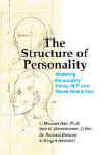 The Structure of Personality
The Structure of Personality
Modeling “Personality” Using NLP and Neuro-Semantics
by
L. Michael Hall, Ph.D., Bob Bodenhamer, D.Min.,
Dr. Richard Bolstad & Margot Hamblett
In this book you will discover that there is no such “thing” as “Personality.” The key word is “thing.” “Personality” is not a thing, but a process. It’s a way of using one’s personal powers of thought, emotion, memory, imagination, speech and behavior. “Personality” is what we DO rather than what we ARE.
Starting from this basic NLP presupposition, the authors have completely denominalized the idea of “personality” so as to create a much more open and responsive model for handling what the medical and psychological communities have nominalized, “Personality Problems.” Instead of speaking about “Personality Disorders,” they speak about personality “disordering.” By returning the language to verbs, the authors then show how that we have three meta-domains as avenues into understanding and transforming “personality.”
These are the three meta-domains of NLP: the Meta-Model, Meta-Programs, and Meta-States. Looking at “personality” with these models enables us to recognize “personality” structures and problems using language (Meta-Model), perceptual filters (Meta-Programs) and states, meta-states, and logical levels (Meta-States). The book presents these three domains and shows the careful reader how to use them to reorder any “personality” disordering.
THE STRUCTURE OF PERSONALITY explores how we actively pattern experience. Using the basic NLP model, the book leads the reader through how we build up a cognitive-emotional behavioral system of responses using internal representations. It examines specific contexts and environments in which personality patterning occurs and the higher levels (layering) of the mind which solidifies our sense of person with beliefs and values.
THE STRUCTURE OF PERSONALITY enables the psychotherapist, hypnotherapist, coach, or informed reader to recognize the structure of ordering personality and so gives valuable insights into re-ordering personality. In Structure of Personality, the reader will find NLP strategies, the RESOLVE model, Meta-States, the Personal Strengths Model, SCORE, and multiple NLP and Neuro-Semantic patterns for transforming personality into something of beauty and power.
THE STRUCTURE OF PERSONALITY targets 14 of the so-called “Personality Disorders” of the DSM-IV and shows how that NLP and NS do not just handle simple problems, but those considered the most severe and unyielding. From schizophrenia to paranoia and addiction, to manic-depressive, THE STRUCTURE OF PERSONALITY provides meta-principles and step-by-step processes along with case studies for the Transformation of personality. Here the magic of NLP shines.
Four world-class NLP Master Trainers have combined to create this work. Begin by L. Michael Hall, Ph.D. as an application of NLP for “personality,” Dr. Bodenhamer filled out much of the work from his pastoral counseling and NLP therapy work. To this Dr. Bolstad and his partner, Margot Hamblett added a psychiatric nursing perceptive. You may not agree with everything in this book, but you will think… and in thinking, you will become more skilled in understanding and working with some of the most challenging problems in human experience.
Reviews:
“A bold and courageous step with exciting possibilities. The authors have dismantled the diagnostic nomenclature offering new perspectives for treatment while postulating that personality is not static; not a thing, but an ongoing, evolving process and, if dysfunctional, can be restructured. The book should prove to be a milestone in our pursuit for sanity.”
Rie Anderson, M.A., LMHC, NBCDCH
Clinical Pshyhotherapist
“The Structure of Personality” is a major step in creating a cognitive map using Neuro-Semantics and Neuro-Linguistic Programming to understand the relationship between a person’s thinking and his or her personality development.”
Jim Walsh, M.A.
Licensed Mental Health Counselor
Certified School Psychologist
Certified Neuro-Semantics and Neuro-Linguistic Trainer
Book Review of The Structure of Personality by Te Ruru, B.A., M.Ed., Cert.Couns.
Book Review of The Structure of Personality by John Burton, Ed.D.
Table of Contents
| Foreword | iii |
| Preface1 | ix |
| Preface2 | xv |
| Part One – NLP and NS Models for Understanding the Structure of Personality | 1 |
| Chapter 1 “Personality” and the Meta-Model” | 3 |
| Chapter 2 The Meta-States Model and “Personality” | 17 |
| Chapter 3 The Strategies Model and “Personality” | 51 |
| Chapter 4 Meta-States, Design Human Engineering and “Personality” | 67 |
| Chapter 5 The RESOLVE Model and “Personality” | 91 |
| Chapter 6 “Personality” as a Meta-Level Phenomena | 111 |
| Chapter 7 The Personal Strengths Model and “Personality” | 127 |
| Chapter 8 Modeling and the Structure of Pathology | 141 |
| Chapter 9 Modeling Pathology | 153 |
| Chapter 10 When Things go Wrong | 169 |
| Chapter 11 Re-discovering the Healthy “Personality” | 183 |
| Chapter 12 NLP and NS Patterns for Transforming “Personality” | 210 |
| Part Two — Specific “Personality” Disordering | 249 |
| Chapter 13 Double-Binding and Schizophrenia | 251 |
| Chapter 14 Disordering “Personality” Through Paranoia | 299 |
| Chapter 15 Disordering “Personality” Through Anti-Social Frames | 309 |
| Chapter 16 Disordering “Personality” Through Depressing | 321 |
| Chapter 17 Borderline Disordering of “Personality” | 343 |
| Chapter 18 Disordering “Personality” Through Histrionic Disordering | 373 |
| Chapter 19 Disordering “Personality” Through Narcissism | 381 |
| Chapter 20 Disordering “Personality” Through Avoidance | 389 |
| Chapter 21 Disordering “Personality” Through Dependence | 399 |
| Chapter 22 Obsessive-Compulsive Disordering | 405 |
| Chapter 23 Disordering “Personality” Through Becoming Addictive | 415 |
| Chapter 24 Disordering “Personality” Through Anxiety-ing | 435 |
| Chapter 25 You and Your “Personality” | 453 |
| NLP and Neuro-Semantic Resources and Patterns | 455 |
| Bibliography | 457 |
The Structure of Personality $49.95 + $10.95 S&H = $60.90
